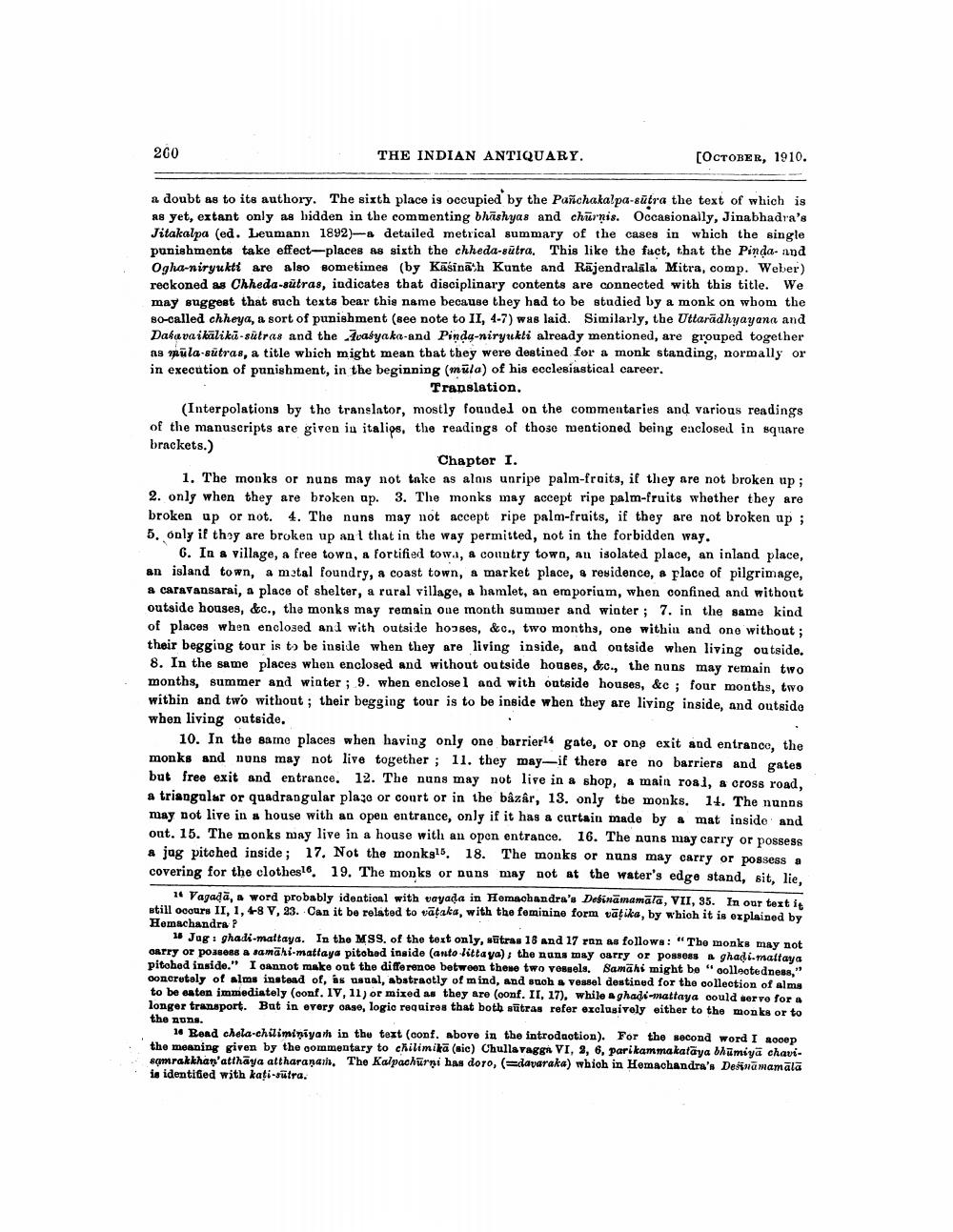________________
200
THE INDIAN ANTIQUARY
[OCTOBER, 1910.
a doubt as to its authory. The sixth place is occupied by the Paschakalpa-sūtra the text of which is R8 yet, extant only as bidden in the commenting bhäshyas and churnis. Occasionally, Jinabhadra's Jitakalpa (ed. Leumann 1892)- detailed metrical summary of the cases in which the single punishments take effect-places as sixth the chheda-sútra. This like the fact, that the Pinda- and Ogha-niryukti are also sometimes (by Kašina'h Kunte and Rajendralāla Mitra, comp. Weber) reckoned as Chheda-sútras, indicates that disciplinary contents are connected with this title. We may suggest that such texts bear this name because they had to be studied by a monk on whom the 80-called chheya, a sort of punishment (see note to II, 4-7) was laid. Similarly, the Uttarādhyayana and Datava ikäliki-sülras and the quasyaka-and Pinda-niryukli already mentioned, are grouped together as mula sutras, a title which might mean that they were destined for a monk standing, normally or in execution of punishment, in the beginning (müla) of his ecclesiastical career.
Translation. (Interpolations by the translator, mostly founded on the commentaries and various readings of the manuscripts are given in italips, the readings of thoso mentioned being enclosed in square brackets.)
Chapter I. 1. The monks or nuns may not take as alas unripe palm-froits, if they are not broken up; 2. only when they are broken ap. 3. The monks may accept ripe palm-fruits whether they are broken up or not. 4. The nuns may not accept ripe palm-fruits, if they are not broken up ; 5. only if they are broken up an that in the way permitted, not in the forbidden way.
6. In a village, a free town, a fortified towa, a country town, an isolated place, an inland place, an island town, a matal foundry, a coast town, a market place, & residence, a place of pilgrimage, a caravansarai, a place of shelter, a rural village, a hamlet, an emporium, when confined and without outside houses, &c., the monks may remain one month summer and winter ; 7. in the same kind of places when enclosed and with outside houses, &c., two months, one within and one without; their begging tour is to be inside when they are living inside, and outside when living outside.
8. In the same places when enclosed and without outside houses, &c., the nuns may remain two months, summer and winter ; 9. when enclosel and with outside houses, &c; four months, two within and two without ; their begging tour is to be inside when they are living inside, and outside when living outside.
10. In the same places when having only one barrier14 gate, or ong exit and entranoo, the monks and nuns may not live together ; 11. they may-if there are no barriers and gates but free exit and entrance. 12. The nuns may not live in a shop, a main road, a cross road, a triangular or quadrangular place or court or in the bâzâr, 13. only the monks. 14. The nunns may not live in a house with an open entrance, only if it has a curtain made by a mat inside and out. 15. The monks may live in a house with an open entrance. 16. The nuns may carry or possess A ing pitched inside ; 17. Not the monks!5. 18. The monks or nuns may carry or possess a covering for the clothes16. 19. The monks or Buns may not at the water's edge stand, sit, lie.
16 Vagadā, a word probably identionl with vayada in Hemachandra's Dekinamamāla, VII, 35. In our texti still occurs II, 1, 48 V, 23. Can it be related to vägaka, with the feminino form vātika, by which it is explained by Hemachandra?
16 Jagghadi-mattaya. In the MSS. of the text only, sutras 16 and 17 ran as follows: "The monks may not arry or possess a samāhi-mattaya pitobed inside (anto litta ya), the nuns may carry or possess ghadi.mattaya pitched inside." Ioannot make out the difference between these two vossols. Samāhi might be "collectedness," concretely of alms instead of, as usual, abstractly of mind, and such a vessel destined for the collection of alme to be eaten immediately (conf. IV, 11) or mixed as they are (oonf. II, 17), while a ghadi-mattaya oould serve for a longor transport. But in every Oase, logio requires that both sutras refer exclusively either to the monks or to the nuns.
10 Rond chala-chiliminiyah in the text (conf. above in the introduotion). For the second word I accep the meaning given by the commentary to chilimikā (sic) Chulla vagga VI, 3, 6, Parikammakataya bhūmiya chavisamrakkhar'atthaya attharana, The Kalpachurri has doro, (davaraka) which in Hemachandra's Dekinamamālā is identified with kati-sutra.




